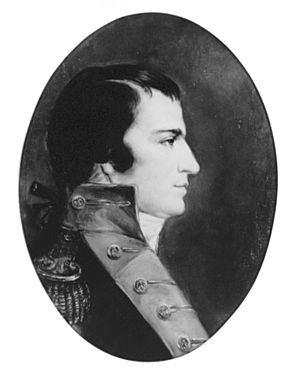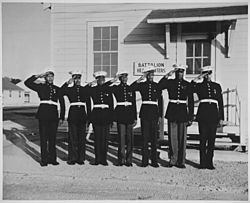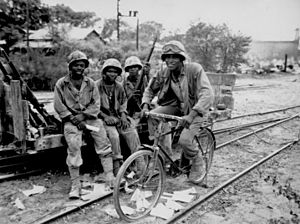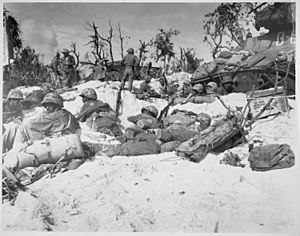Desegregation in the United States Marine Corps facts for kids
The United States Marine Corps (USMC) is a military group made up of people from all backgrounds working together. This wasn't always the case. In the early days, during the American Revolutionary War (1776-1777), a few Black American Marines served. But for over 140 years, from 1798 to 1942, the USMC did not allow African Americans to join. They mostly recruited white Americans and some Asian Americans.
In June 1942, the USMC finally started accepting African Americans. However, these new recruits were placed in separate, all-Black units. Other races were allowed to join white Marine units more easily. It took many years for the USMC to fully integrate, meaning people of all races could serve together. This change was pushed by special orders from the President in 1941 and 1948. Slowly, Black troops moved from segregated groups in 1942 to training together in 1949, and finally, full integration by 1960. By 2006, about 20% of the USMC was Black American and 15–18% Hispanic.
Contents
Early History
During the American Revolutionary War, Black American soldiers fought alongside white soldiers in the Continental Army. This continued until the War of 1812. The first Black American to serve as a Marine was John Martin in April 1776. He was a slave from Delaware who joined without his owner's permission. Martin served on a ship called the Reprisal for about a year and a half. He was lost at sea when the ship sank in 1777.
At least 12 other African Americans served with Marine units during the Revolutionary War. When the US Marine Corps was officially formed in 1798, the Secretary of War, James McHenry, made it clear that Black people could not officially join. He said they could be used for temporary work but not enlisted.
For many years, the USMC did not have any African Americans serving. However, the U.S. Navy often had Black sailors during the same time. During the American Civil War, about 180,000 African Americans joined the Union Army. They mostly worked in support roles like driving trucks, building things, and cooking. Some also fought in segregated units led by white officers. In later wars, the United States Army used Black soldiers, but the United States Navy only used Black sailors for support jobs, not combat. The Marine Corps, being a combat part of the Navy, did not recruit any Black Marines.
Changes During World War II

During President Franklin D. Roosevelt's time, African Americans gained more political power. Groups like the National Association for the Advancement of Colored People (NAACP) pushed for equal rights. They wanted more Black people in the military. In 1940, a Black newspaper called the Pittsburgh Courier formed a group to help Black people join the military.
Black community leaders saw World War II as a chance to gain more equality at home. They argued that if Black people were loyal to the country, they should have equal rights. In 1941, civil rights leaders like A. Philip Randolph planned a big march on Washington, D.C. They wanted the President to order fair employment for Black people in the government. To stop this march, President Roosevelt issued Executive Order 8802 on June 25, 1941. This order banned racial discrimination in federal jobs, agencies, the military, and defense companies.
President Roosevelt and Navy Secretary Frank Knox told the Marine Corps to accept Black recruits. The Marine Commandant, Major General Thomas Holcomb, suggested creating a separate battalion (a military unit) for African Americans. This unit would be a defense battalion with anti-aircraft guns. He wanted it to be self-supporting, with Black Marines doing all the jobs, including fighting.
Montford Point Marines
Alfred Masters was the first African American to join the USMC on June 1, 1941, in Oklahoma City. This was the first time since the Revolutionary War that a Black person officially enlisted. Even though Black recruits were accepted starting June 1, 1942, they couldn't start training right away. Separate training facilities were not ready.
Black volunteers began their basic training in August 1942 at Montford Point in North Carolina. This was a special base for Black Marines. The first Black recruit to arrive was Howard P. Perry on August 26. These recruits formed the 51st Defense Battalion. This unit was meant to hold land against attacks.
At first, the Marine Corps made it hard for Black recruits to join. They required them to already know skills like typing or truck driving. This caused delays, so the rule was dropped. White Marine instructors taught the Black recruits specialist skills at Montford Point.
Black recruits were not allowed in the main Camp Lejeune unless they were with a white Marine. Their service papers were even stamped "Colored." Their units were completely segregated: all the enlisted Marines were Black, but the officers and drill instructors were white. Over time, Black sergeants and corporals began to replace the white drill instructors.
Fighting in the Pacific
After more Black recruits joined, the USMC formed the 52nd Defense Battalion. Alfred Masters was moved to this unit and became a Technical Sergeant. Both the 51st and 52nd Battalions went to fight in the Pacific War. They were defense units, meaning they held land behind the main fighting lines, so they didn't see much direct combat.
In total, 19,168 African Americans joined the Marines during World War II. This was about 4% of the USMC's total strength. About 75% of them served overseas. Around 8,000 Black USMC stevedores (people who load and unload ships) and ammunition handlers worked under enemy fire during battles in the Pacific.
After the Battle of Saipan in June 1944, USMC General Alexander Vandegrift praised the all-Black 3rd Marine Ammunition Company. He said, "The Negro Marines are no longer on trial. They are Marines, period." This showed that their hard work and bravery were being recognized.
Another example of their bravery happened at Peleliu in September 1944. During a tough battle, the 7th Marines needed help getting wounded soldiers to safety and bringing ammunition to the front lines. Two segregated companies, the 16th Marine Field Depot and the 17th Special Seabee unit, came to their aid. These Black Marines carried ammunition on stretchers and even picked up rifles to fight as infantrymen. The Seabees also volunteered to man the lines and operate guns that had lost their crews. Historians say that without these "Black Marine shore party personnel," the counterattack on the 7th Marines would not have been stopped.
- The 33rd and 73rd Seabee units received special awards called Presidential Unit Citations for their actions on Peleliu. The commanders of the 7th Marine Ammo Co., the 11th Marine Depot Co., and the 17th Special CB all received a letter of praise from Major General Rupertus. He wrote that the "Negro race can well be proud" of their work and that they had "earned a WELL DONE" from the entire division.
After World War II
After World War II, the USMC became smaller. The number of African-American Marines dropped significantly. In 1947, Black Marines were forced to choose between leaving the service or becoming a steward (a food service job). However, some non-white Marines did advance. For example, Kurt Chew-Een Lee, a Chinese-American Marine, became an officer in 1946. He earned a high award, the Navy Cross, for his bravery in Korea in 1950.
On July 26, 1948, President Harry S. Truman issued Executive Order 9981. This order said that everyone in the U.S. military should be treated equally, no matter their race. He created a committee to make sure this happened. In 1949, this committee met with military leaders. The Army and Marine Corps leaders still wanted to keep their units segregated. However, the Navy and the new United States Air Force said they would follow the order. The USMC noted that it had very few Black officers at the time.
By late 1949, all-Black USMC units still existed, but Black and white recruits started training together. Black USMC officers were only assigned to lead Black units, not white ones. In 1952, after two years of the Korean War, the Marines slowly began to integrate Black soldiers into combat units. By 1960, the USMC had fully integrated all races. However, racial tensions continued to be a challenge throughout the 1960s, a time of major civil rights changes in the country.
Stories and Recognition
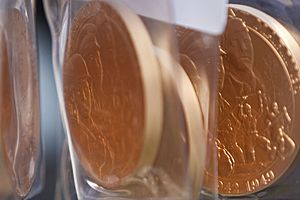
In May 2011, a theater group in Saint Louis, Missouri performed a new play called The Montford Point Marine. This play was about a veteran from the Montford Point unit and his life after serving in Korea. This helped bring the story of these brave Marines to a wider audience.


